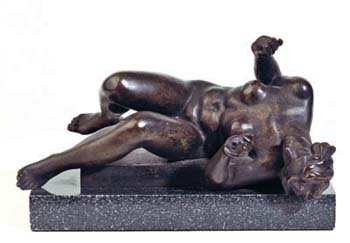The River
- Modeling begun in 1938; cast date unknown
- Aristide Joseph Bonaventure Maillol (French 1861-1944)
- Cast bronze attached to marble base
13.9 x 27.0 x 15.4 cm., 5-1/2 x 10-5/8 x 6" without base
- Catherine Carter Goebel, Paul A. Anderson Chair in the Arts Purchase, Paul A. Anderson Art History Collection, Augustana College 2007.10

Essay by Dara Wegman-Geedey, Professor of Biology
At first glance, one may not understand the message that Aristide Maillol conveyed through sculpture. In this digital era, when maximum pixels and "high res" are prized characteristics of the electronic gadgetry we crave, the more "life-like" or 3D that an image is on our viewing screens, the greater our perception of reality. To appreciate The Crouching Girl and The River, we must step off the path of "authenticity through minute detail" and consider the larger themes in Maillol's work.
Maillol sculpted during the late 19th and early 20th centuries, using a style uniquely his own but reminiscent of early Greek statues. Maillol, like the Greeks, found the human body the most important subject for artistic expression. Scholars believe the Greeks highly valued the body because they envisioned gods as having human forms, but Maillol's interest seems due to the malleable nature of the thing itself. Not only could the human torso and limbs assume many poses, allowing Maillol to play with positive mass and negative space in his sculptures (e.g., filled vs. open shapes), but the human figure was also an archetype used to express his ideal of beauty in nature. Maillol once said that "The human form is far older than the emergence of man, who had only to mould himself in the image of the primitive creatures swarming around him to give himself an appearance of balance, beauty and harmony" (George 43).
Though Maillol, like most artists, had a favorite model, his sculptures are not depictions of her specifically. In his words, ".a man (or a woman) is no more important, plastically speaking, than any given rock, animal or bush" (Chevalier 29). Faces and other structures are expressionless and anonymous in Maillol's sculptures. Like fellow French sculptor, Auguste Rodin, Maillol sometimes took pieces from one statue to add to another. His work is thus simultaneously abstract and representative. The controlled pose of The Crouching Girl is more representative of Maillol than is The River, part of a commissioned piece that he chose to finish when funding ceased. The contorted posture of The River bespeaks an emotional response requested by the original patron, but is evidence that Maillol could sculpt great detail and emotion, but typically chose otherwise.
